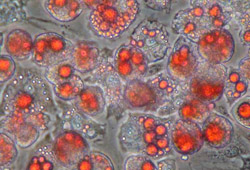Resumo
Definição
História e exame físico
Principais fatores diagnósticos
- índice de massa corporal (IMC) ≥95º percentil
- peso por altura ≥ percentil 95
Outros fatores diagnósticos
- aumento da relação cintura-quadril
- hipertensão
Fatores de risco
- pais com obesidade
- rápido ganho de peso na infância
- rápido ganho de peso no começo da infância
- etnia negra não hispânica ou hispânica
- status socioeconômico desfavorável
- estilo de vida sedentário
- restrição do crescimento intrauterino
- diabetes gestacional
- dieta rica em alimentos industrializados, fast food e bebidas com grande teor de açúcar
- tempo em frente à tela >2-3 horas/dia
- privação de sono
- exposição a corticosteroides, antibióticos ou medicamentos para supressão ácida
- ambiente urbano
- tabagismo materno durante a gestação
- consumo materno de alimentos ultraprocessados
Investigações diagnósticas
Primeiras investigações a serem solicitadas
- diagnóstico clínico
Investigações a serem consideradas
- glicemia de jejum
- lipídios séricos
- testes da função hepática
Novos exames
- absorciometria por dupla emissão de raios X (DXA)
- análise de impedância elétrica
- ressonância nuclear magnética (RNM) ou tomografia computadorizada (TC) abdominal
Algoritmo de tratamento
índice de massa corporal (IMC) ≥85º ao 94º percentil (sobrepeso)
índice de massa corporal (IMC) ≥95º percentil (obesidade) ou IMC ≥120% do 95º percentil (obesidade grave)
Colaboradores
Autores
Dianne Deplewski, MD
Associate Professor of Pediatrics
Section of Adult and Pediatric Endocrinology
Program Director
Pediatric Endocrinology Fellowship Program
University of Chicago
Chicago
IL
Declarações
DD declares that she has no competing interests.
Agradecimentos
We would like to acknowledge our Paediatric expert panel member, Dr Michael Cabana, for his contribution to this topic. MDC declares that he has served as a consultant and editor for McGraw Hill and Elsevier.
Revisores
Eric M. Bomberg, MD, MAS
Assistant Professor of Pediatrics
Associate Director for Research Informatics, Center for Pediatric Obesity Medicine
Division of Endocrinology and Center for Pediatric Obesity Medicine
University of Minnesota Medical School
Minneapolis
MN
Declarações
EMB declares that he has been a site principal investigator and site co-investigator for Novo Nordisk. EMB's research program is supported by the National Institutes of Health (NIH) National Institute of Diabetes and Digestive and Kidney Diseases (NIDDK).
Steven S. Rothenberg, MD
Chief of Pediatric Surgery
The Mother and Child Hospital
Associate Clinical Professor of Surgery
University of Colorado
Denver
CO
Declarações
SSR declares that he has no competing interests.
Seema Kumar, MD
Assistant Professor of Pediatrics
Mayo Clinic
Rochester
MN
Declarações
SK declares that she has no competing interests.
Peter Bundred, MBBS, MD
Honorary Research Fellow
Department of Health Services Research
Institute of Psychology, Health and Society
University of Liverpool
Liverpool
UK
Declarações
PB declares that he has no competing interests.
Créditos aos pareceristas
Os tópicos do BMJ Best Practice são constantemente atualizados, seguindo os desenvolvimentos das evidências e das diretrizes. Os pareceristas aqui listados revisaram o conteúdo pelo menos uma vez durante a história do tópico.
Declarações
As afiliações e declarações dos pareceristas referem--se ao momento da revisão.
Referências
Principais artigos
Hampl SE, Hassink SG, Skinner AC, et al. Clinical practice guideline for the evaluation and treatment of children and adolescents with obesity. Pediatrics. 2023 Feb 1;151(2):e2022060640.Texto completo Resumo
Hampl SE, Hassink SG, Skinner AC, et al. Executive summary: clinical practice guideline for the evaluation and treatment of children and adolescents with obesity. Pediatrics. 2023 Feb 1;151(2):2022060641.Texto completo Resumo
Styne DM, Arslanian SA, Connor EL, et al. Pediatric obesity - assessment, treatment, and prevention: an Endocrine Society clinical practice guideline. JCEM. 2017 Mar 1;102(3):709-57.Texto completo Resumo
US Department of Health and Human Services (HHS) and US Department of Agriculture (USDA). Dietary guidelines for Americans 2020-2025. 9th ed. Dec 2020 [internet publication].Texto completo
Artigos de referência
Uma lista completa das fontes referenciadas neste tópico está disponível para os usuários com acesso total ao BMJ Best Practice.

Diagnósticos diferenciais
- Hipotireoidismo primário
- Hipotireoidismo secundário
- Síndrome de Cushing
Mais Diagnósticos diferenciaisDiretrizes
- Obesity: identification, assessment and management
- Clinical practice guideline for the evaluation and treatment of children and adolescents with obesity
Mais DiretrizesFolhetos informativos para os pacientes
Problemas de peso em crianças
Mais Folhetos informativos para os pacientesConectar-se ou assinar para acessar todo o BMJ Best Practice
O uso deste conteúdo está sujeito ao nosso aviso legal